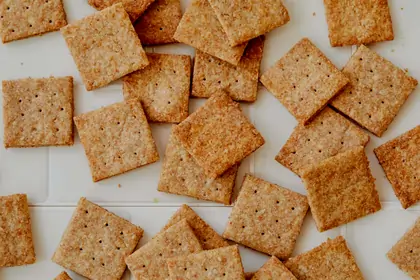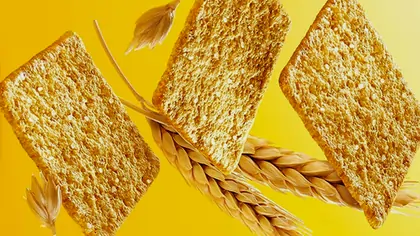Introduction
A common and well-liked snack for many people is Wheat Thins. They are tasty, crunchy, and convenient, making them a staple in many households. However, as people become more health-conscious, there is growing interest in understanding Wheat Thins nutrition. This guide aims to provide a comprehensive look at what makes up these beloved crackers, their health benefits, potential drawbacks, and how they can fit into a balanced diet. Let’s dive in!
What Are Wheat Thins?
Wheat Thins are a well-known snack introduced by Nabisco in 1947. These thin, square crackers are crafted from whole grain wheat, offering a wholesome and satisfying crunch. Available in a variety of flavors and styles, including Original, Reduced Fat, and Whole Grain, Wheat Thins cater to diverse taste preferences and dietary needs.

Their simple ingredients and versatile nature have contributed to their enduring popularity. Whether enjoyed on their own, paired with cheese, or dipped in hummus, Wheat Thins are a convenient and tasty snack option that has remained a favorite in households for decades.
Wheat thins Nutritional Breakdown
Serving Size and Calories
When considering Wheat Thins nutrition, it’s important to start with the basics. A standard serving size of Wheat Thins is about 16 crackers, weighing 31 grams. This serving contains approximately 140 calories. For a snack, this is a moderate calorie count, making it a reasonable choice for those watching their intake.
Macronutrients in Wheat Thins
- Carbohydrates: Wheat Thins are primarily composed of carbohydrates. Each serving contains about 22 grams of carbohydrates, providing a quick source of energy.
- Protein: With about 2 grams of protein per serving, Wheat Thins are not a significant source of this macronutrient, but they do contribute a small amount to your daily intake.
- Fats: Wheat Thins contain around 5 grams of fat per serving. This includes a mix of saturated and unsaturated fats, essential for providing energy and supporting overall health.
Fiber Content
A standout feature of Wheat Thins nutrition is their fiber content. Each serving provides about 3 grams of dietary fiber, which is beneficial for maintaining digestive health and helping you feel full longer.
Sugar and Sodium Levels
Wheat Thins contain around 4 grams of sugar per serving, mostly from added sugars. Sodium content is relatively high, with each serving containing about 200 milligrams. While this contributes to their savory taste, it’s something to be mindful of if you’re watching your sodium intake.
Vitamins and Minerals in Wheat Thins
Wheat Thins nutrition also includes various vitamins and minerals:
- Vitamins: Wheat Thins provide small amounts of essential vitamins like Vitamin E and B vitamins, which are important for energy production and immune function.
- Minerals: These crackers offer minerals such as iron and magnesium, crucial for oxygen transport and muscle function, respectively.

Health Benefits of Wheat Thins
Digestive Health
Thanks to their fiber content, Wheat Thins nutrition can aid in maintaining a healthy digestive system. Constipation can be avoided and regular bowel motions are encouraged by fiber.
Energy Boost
With a good balance of carbohydrates and fats, Wheat Thins provide a quick energy boost, making them an ideal snack for busy days.
Snack Convenience
Their portability and non-perishable nature make Wheat Thins a convenient snack option for on-the-go lifestyles.
Potential Drawbacks of Wheat Thins
High Sodium Content
Consuming too much salt can cause high blood pressure and other cardiovascular problems.
Added Sugars
The presence of added sugars, though relatively low, can be a concern for those managing their sugar intake, such as diabetics.
Potential Allergens
Wheat Thins contain wheat and may contain traces of soy and other allergens, making them unsuitable for people with specific food allergies.

Wheat Thins vs. Other Snacks
Comparison with Similar Snacks
When compared to other popular snacks like Triscuits and Ritz Crackers, Wheat Thins offer a unique nutritional profile. For example, Triscuits are often higher in fiber, while Ritz Crackers may have higher fat content.
Nutritional Differences
Wheat Thins nutrition generally provide a balanced mix of carbohydrates, fats, and fiber, whereas other snacks may focus more heavily on one macronutrient.
Healthier Alternatives
For those seeking healthier options, whole grain crackers with lower sodium and no added sugars can be a better choice. Homemade snacks using whole ingredients can also be a great alternative.
Incorporating Wheat Thins into a Balanced Diet
Portion Control
To enjoy Wheat Thins nutrition without overindulging, it’s important to practice portion control. Stick to the recommended serving size and avoid mindless snacking.
Pairing with Healthy Foods
Pair Wheat Thins with healthy foods like hummus, low-fat cheese, or fresh vegetables to create a balanced snack that satisfies both taste and nutritional needs.
Snack Ideas
Use Wheat Thins as a base for mini sandwiches, topped with lean protein and vegetables, or enjoy them with a nutritious dip for a satisfying snack.
Wheat Thins for Special Diets
Gluten-Free Options
While traditional Wheat Thins contain gluten, there are gluten-free alternatives available that cater to those with gluten sensitivities or celiac disease.
Vegan and Vegetarian Considerations
Most varieties of Wheat Thins are suitable for vegetarians and many are vegan-friendly, but always check the label to ensure there are no animal-derived ingredients.
Low-Sodium Versions
For those watching their sodium intake, reduced-sodium Wheat Thins are available, providing the same great taste with less sodium.

Homemade Wheat Thins Recipes
Benefits of Making Your Own
Making your own Wheat Thins at home allows you to control the ingredients, ensuring they are fresh and free from unwanted additives.
Simple Recipe
To make homemade Wheat Thins, combine whole wheat flour, olive oil, water, and a pinch of salt. Roll out the dough, cut into squares, and bake until crispy.
Customization Ideas
Add your favorite herbs and spices to the dough for a personalized flavor. Try adding garlic powder, rosemary, or even a touch of cheese for a unique twist.
Conclusion
Wheat Thins nutrition offers a mix of benefits and drawbacks. While they provide a convenient and tasty snack option with a decent amount of fiber, they also contain added sugars and higher sodium levels. By understanding their nutritional content and incorporating them mindfully into your diet, you can enjoy Wheat Thins as part of a balanced and healthy lifestyle.
Follow here for more related information
Frequently Asked Questions (FAQs)
1. Are Wheat Thins healthy?
Wheat Thins can be a healthy snack when consumed in moderation. They provide fiber and essential nutrients but also contain added sugars and sodium.
2. Can Wheat Thins help with weight loss?
Wheat Thins can be part of a weight loss plan if eaten in controlled portions and paired with other healthy foods to ensure a balanced diet.
3. Do Wheat Thins contain gluten?
Yes, traditional Wheat Thins contain wheat and gluten. However, there are gluten-free alternatives available.
4. How much fiber is in Wheat Thins?
Each serving of Wheat Thins provides about 3 grams of dietary fiber, contributing to digestive health.
5. Are there any vegan Wheat Thins?
Many varieties of Wheat Thins are vegan, but it’s important to check the ingredient list to ensure there are no animal-derived components.

1 thought on “Wheat Thins Nutrition: Is it Healthy or not ?”